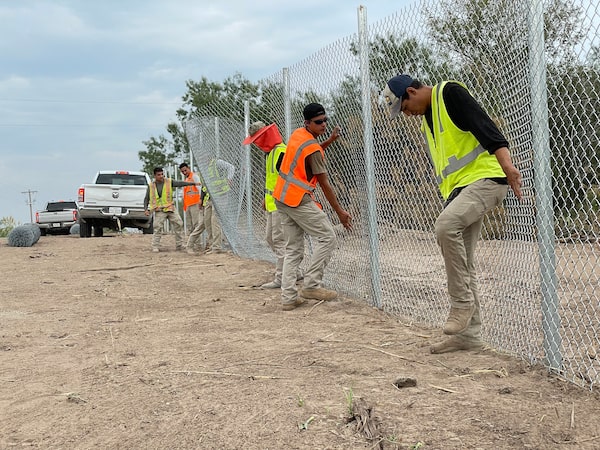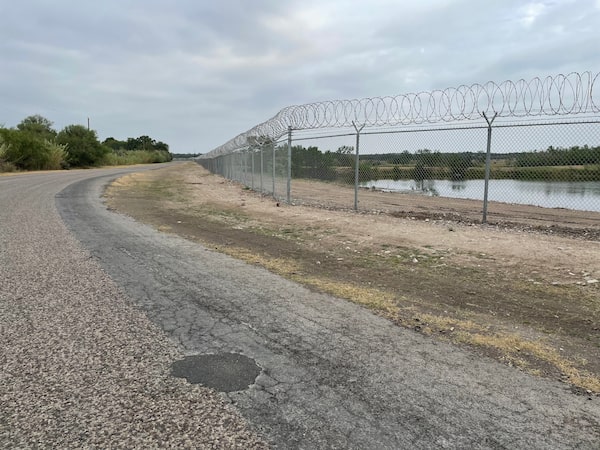
Workers erect new state-funded fencing along Vega Verde Road outside Del Rio, Texas, on Sept. 21, 2021. The past year has seen more migrants apprehended by U.S. law enforcement than at any other point in the past two decades.Nathan VanderKlippe/The Globe and Mail
The line of workers braces against a stretch of chain-link fencing, lifting it as a pickup truck pulls it tight against metal poles. The Rio Grande flows just down a sandy embankment across the road from where they are working. On its other side lies Mexico, the point of departure of more than a million people who have been apprehended crossing into the U.S. without papers in the past year and the reason Texas is taking up where Donald Trump left off, and once again building barriers along the border.
“Stop!” a foreman yells, after the chain link slips into place. “Oh, so beautiful,” he says, pausing to admire his work before moving on to the next section.
Just north of the Texas border town of Del Rio, Vega Verde Road extends eight kilometres along the Rio Grande, and the fence already stretches into the distance, finished portions crowned with a gleam of razor wire. Along other pockets of the border, too, new fence is taking shape, backed by a state whose eagerness for new walls has only grown with the sudden arrival of nearly 15,000 people, many of them from Haiti, who formed an encampment beneath a Del Rio bridge.
U.S. Border Patrol takes thousands into custody as tension escalates at Del Rio, Texas
“If a river can’t stop them, hopefully a fence can,” said David Arredondo, a worker building a steel-roofed shelter along the river a short drive from that bridge.
The past year has seen more migrants apprehended by U.S. law enforcement than at any other point in the past two decades, with more than 1.5 million people found entering the country illegally via Mexico in the past 11 months, more than triple the previous year.
Retired teacher Yolanda Fernandez, who lives near the Rio Grande just north of Del Rio, disliked the idea of a border wall when it was proposed by Mr. Trump.
But her home is testament to the fears brought to her by the regular passage of strangers across her property. The windows are covered with iron bars. Two Rottweilers – Charra and Oso – strain at their chain leashes in furious barking when they see a stranger. At night, Ms. Fernandez and her husband let the two dogs free to guard the property.

Yolanda Fernandez stands with Charra, one of two Rottweilers she and her husband keep on their property near the Mexico border outside Del Rio.Nathan VanderKlippe/The Globe and Mail
Even so, in June they counted 150 people walking through their property in a single day, in the early days of the wave of Haitian migrants that has created the most acute border crisis to confront the Joe Biden administration. Mr. Biden paused border-wall work shortly after taking office and has since cancelled a number of construction contracts.
But Ms. Fernandez, like many of her neighbours, has changed her mind on the idea – and now welcomes the effort by Texas Governor Greg Abbott to erect new fences, even if, at less than three metres in height, the chain-link Texas version is diminutive in comparison with the nine-metre colossus that Mr. Trump ordered in some places.
In recent years, the flow of people through the Fernandez property has destroyed fences and left behind dirty toilet paper and other litter. Their home has been repeatedly burglarized. Once, Ms. Fernandez’s husband sped across the border and found the burglars unloading the family possessions on the other side of the river.
But the number of people has slowed dramatically in recent weeks. Ms. Fernandez credits the new fencing.
“Are we happy that the wall is being built? Yes. I’m sorry about these people and what they’re going through. But I’m glad, because it’s going to stop the burglarizing.”
Options shrink for thousands of Haitian migrants straddling the Mexico-Texas border
Walls are not new to the southern frontiers of the U.S. Earlier this year, U.S. Customs and Border Protection reported that barriers have been erected alongside 1,240 kilometres of the 3,145-kilometre border. Mr. Trump claimed credit for building 727 kilometres of wall during his time in office. But only about a 10th of that was in areas without some sort of barrier already in place.
Now Mr. Abbott is determined to build more, working with landowners willing to allow crews to install the new fences. He has committed to spend US$3-billion on the border and petitioned the White House to declare a disaster in areas affected by migrant crossings.
Much of that money is funding the fleets of police and other personnel that have descended upon border towns such as Del Rio, in part to enforce a new order to arrest migrants for trespassing on private and state property. Mr. Abbott called it a “steel barrier” of guns and vehicles to block people from crossing.
But roughly US$1-billion of the new spending has been designated for construction of actual steel barriers, in places where the state can secure the agreement of landowners. The Texas Department of Public Safety has identified 1,179 kilometres “where some kind of barrier may be necessary,” Renae Eze, a press secretary to Mr. Abbott, said in a statement.
“The state has taken the next step in the process by recently hiring a program management firm through the Texas Facilities Commission to lead the planning and execution of the border wall construction project.”

New state-funded border fence stretches into the distance along Vega Verde Road, near Del Rio.Nathan VanderKlippe/The Globe and Mail
On Tuesday, the Governor came to the weir on the Rio Grande where thousands of migrants crossed in the past week, determined to make the case that the state will do what the White House will not.
“If you are targeting Texas to come to, we are going to show up in force and shut down the border,” Mr. Abbott said. “We’re not going to allow the disaster that we saw here in Del Rio to be replicated.”
Building new fence is not cheap. At one spot roughly 100 kilometres south of Del Rio, it cost nearly $10-million per kilometre, said Eddie Morales, a member of the Texas House of Representatives who was among the few state Democrats to support the border security bill that will pour new state money into fence-building. He supported an amendment to ensure the state could not appropriate land for border fencing. He nonetheless remains skeptical.
“We think it’s ineffective. I’d rather have high-tech equipment and manpower – boots on the ground to address the issue – rather than a wall,” he said.
Those charged with seizing migrants are enthusiastic.
“It’s not just one wall across the entire southwest border. But it’s in strategic locations, so that we can control where the illegal immigration takes place,” said Brandon Judd, president of the National Border Patrol Council, the union for border guards. “If we can control that, we can be a lot more effective in what we’re doing.”
Others confess skepticism. “The fence is good. It’s a deterrent. It slows stuff down. But those people that lead them across” – the human smugglers directing migrant movements – “they know where to go and where to get through,” said Randy Abbey, another landowner near Vega Verde Road. “It’s kind of like putting a Band-Aid on a wound.”
Robb Jump has seen those smugglers. Living on the shores of the Rio Grande, he often watches men with binoculars occupying sentry posts on a sandy hill across the water in Mexico.
Even so, the idea of a fence lost its lustre once he saw it take shape across the road from his home in recent weeks. “It’s just become kind of a burden,” he said. Rather than prevent people from crossing the river, he expects the fence to channel more people by his property as they walk alongside the fence toward town.
“I was all about it until they did it,” he said. “Now I’m looking at it like it’s kind of fruitless.”
Our Morning Update and Evening Update newsletters are written by Globe editors, giving you a concise summary of the day’s most important headlines. Sign up today.
 Nathan VanderKlippe
Nathan VanderKlippe